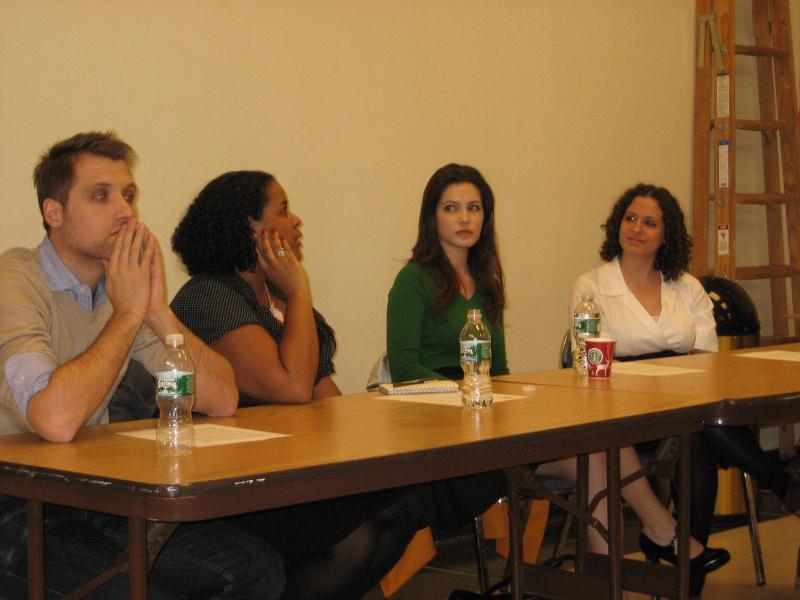At last week’s Dot-Com Panel, edsters heard panelists discuss the death of print, love of self-promotion, and why top ten lists get the most traffic. Read on for more advice from panelists (from left) Marc Boxser who has worked as a Digital Media Consultant at grist.org and several other sites, Dodai Stewart, Senior Editor at jezebel.com, Julia Allison, co-founder of nonsociety.com, and Julie Hochheiser, Senior Web Editor at seventeen.com.
1. Be your own editor, publisher, and PR rep.
Online writers multitask by taking on more masthead titles. “You have to know how to package a story with a combination of a headline and picture. What may work at a magazine will not necessarily work for the web,” Stewart says. “I don’t make a distinction between editorial and marketing anymore,” Allison adds. “I have to worry about revenue stream.”
2. Study the best and worst of the web.
Reading blogs isn’t enough. The Daily Beast has been getting a lot of buzz, but can you explain its reason for success? “We want to know why you love a site. For example, you love how they aggregate news stories,” Boxser says. “You should be able to compare and contrast them,” adds Allison. And always have ideas for improvement. “We would also be asking what could you do to make it snappy and exciting,” Stewart says.
3. Know your CPM from your HTML.
“I would never show up at an interview not knowing basic HTML or photoshop,” Hochheiser says. “You can teach yourself for free. There’s no reason not to do it. If a 16-year-old can do it, so can you.” Sneaking digital buzzwords like search engine optimization, CPM, page views versus unique visitors, and information architecture are great for interviews.
4. Understand how sites make money.
Pitches need to include how your idea will drive traffic, including research on how similar stories fared on Google in the past and which demographic you’re trying to reach, Stewart says. “What are the possible sponsors? Welcome to entrepreneurial journalism. That’s how you want to think about stories,” Allison says. “What are the time-suckers? It’s about thinking outside the box to drive traffic,” Hochheiser says, citing Seventeen.com’s flipbook as an example of retooling content to get more time spent on the page.
5. Get published online.
Allison advises pitching the web editor a full package and offering to do it for free until they start depending on you and offer compensation. Stewart wrote unpaid movie reviews for Stuff.com along with fashion stories for LHJ.com. “I definitely think you should offer to work for free. Most web stories have a short word count and don’t take up a lot of time. Get your name out there,” Stewart says.
6. Join the blogosphere.
If you don’t have clips, show your writing in a blog. “That’s where we can see what you can really do without being edited,” Allison says. But a post detailing your latest hook-up or barhop may not be the best idea. “If you want your career to be online, you should have two blogs: one career and one personal. I don’t think everything’s appropriate. It’s one thing to have a personality and another thing not to be hirable,” Stewart says. “Your facebook and LinkedIn pages are your resume,” Boxser adds.
7. Whip out that dusty camcorder.
Most journalists are not amateur filmmakers, but video makes a lot more money than anything else, says Boxser. Allison produces videos for Time Out New York. “It’s like putting on a wedding every day, but you can teach yourself,” she says. She advises everyone to try a few practice runs, and then take notes after watching yourselves on camera. With editing programs like Final CutPro and a few hours studying basic news segments or YouTube’s most popular videos, you can see what works and what doesn’t.
8. Network beyond your computer screen.
The best way to meet high-profile journalists is to ask them for an interview. “Of the emails I’ve answered, they have been for interviews,” Stewart says. “Someone who has a blog about curly hair wanted to ask me about my conditioner. I loved that.” Allison used her dating column in amNew York to interview people she wanted to meet including Kate White and Bonnie Fuller, who hired her ten months later. “I went from $50 a column to a six figure salary in a week,” Allison says.
9. Party with fellow bloggers.
Like in print, online gigs usually come from connections. When looking for freelancers, Stewart says, “We always ask, ‘Do you know any cool writers?’” Boxser suggests meeting people at industry parties. “In the video web world, there are a ton of industry parties. Lot’s of people in the field are there,” he says. Allison covered parties for nymag.com as a way of meeting New York personalities. Boxser advises attending press events—a movie blog can be enough to get a pass.
10. Be persistent.
“You have to email me seven or eight times to get my attention. I have 4200 emails in my inbox from the past two months. You’re not being a stalker; you’re doing what it takes to get my attention,” Allison says. Hochheiser prefers meeting budding digital editors for informationals to getting pitched random ideas. “I don’t have time to read your quiz idea. An email of more than one line usually goes to the trash,” she says. Stewart has 1600 unread emails from December. “I do like pitches, but I’m probably not going to read them the first time around,” she says.




 How to Seal the Deal
How to Seal the Deal